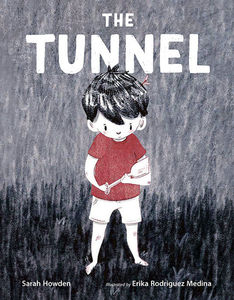"Sometimes People Think Children Just Bounce Back" Sarah Howden on Her Thoughtful New Picture Book Helping Kids Navigate Loss
Talking to kids about tough subjects, including grief and loss, is one of the most disorienting parts of being a parent or caregiver. Children need a way to navigate sadness, but the language and concepts used to help adults can easily get overwhelming.
Enter Sarah Howden's thoughtful new picture book, The Tunnel (Owlkids). Brought to life with muted and gentle greyscale illustrations by Erika Rodriguez Medina (which also feature accents in red), the story follows a boy who is feeling sad after an unspecified bad thing has happened.
His mom and aunt want to talk, but he's not ready, and finds solace by digging the titular tunnel in his backyard. In the cozy darkness, he has time and space to himself, and the lights of his house start to feel warm and welcoming again.
The journey back through the tunnel is a gentle metaphor for navigating our toughest moments, and how we sometimes need space and agency in order to do so. The Tunnel is obviously a helpful tool to talk through tough issues kids may be experiencing, but even for young readers who aren't struggling with a negative event, it's a wonderful kid-friendly way to build foundations for empathy, kindness, and self-advocacy. This healing story is a gift to caregivers and young readers, and we're excited to welcome Sarah to Open Book today to talk about it.
She tells us about how parenting through the pandemic, as well as her own childhood, inspired her to write this book as a "conversation with the little girl I was", why she wants to let kids know "it’s okay not to have the words", and what writing for children and writing poetry have in common.
Open Book:
Tell us about your new book and how it came to be.
Sarah Howden:
The Tunnel is about a little boy dealing with loss. Even though his mother tries to comfort him, and his aunt wants him to talk about it, he just wants to be left alone—so he gets his shovel and digs a hole from his room down into the earth. After some digging, he emerges in his own backyard. There, he faces a moment where he has to decide: do I go back, or do I keep tunneling? When he sees his mother’s face in the lit window, he decides he wants to go back; he wants to go home.
I think the difficulties of Covid, and trying to help my young daughter through these hard times, made me reflect back on my childhood, when I also faced a few upheavals. And I remember keenly trying to pretend I was okay, and my first instinct being to push away the people who wanted to help. This book is a bit of a conversation with the little girl I was, I guess.
OB:
Is there a message you hope kids might take away from reading your book?
SH:
I hope some readers will relate to the main character and understand their feelings a bit better because of that connection. Life isn’t easy, and sometimes people think children just bounce back or steamroll over the troubling bits. I hope kids can read this and, if they’ve experienced some kind of loss, know that it’s okay to want some time to yourself, it’s okay not to have the words. To find your own space, when you need it. And not to feel bad about this, and about your grief—but also not to feel bad for coming back, and for needing the comfort of those who love you.
Your CanLit News
Subscribe to Open Book’s newsletter to get local book events, literary content, writing tips, and more in your inbox
OB:
Do you feel like there are any misconceptions about writing for young people? What do you wish people knew about what you do?
SH:
Sometimes I think people believe writing kids’ books is incredibly simple—that you whip off ten manuscripts in an hour, because they’re so short. It’s not that I want to create some mystique of how complex it is, but I do like to compare it to writing poetry. Poems can be short, certainly they’re much more concise than novels; but that means the writer has to choose their words, their rhythm, with a lot of precision and care. As a picture book takes shape, you’re balancing out the story with the word choices and the flow and the illustrations, and these all need to work together seamlessly in a way that seems effortless. So, writing for children has more layers to it than it might seem (while also, I shouldn’t forget to say, being really fun).
OB:
What defines a great book for young readers, in your opinion? Tell us about one or two books you consider to be truly great kids books, whether you read them as a child or an adult.
SH:
This is obviously an impossible question because there are just so many, but I’m going to do a “first thought, best thought” thing and go with the two that sprang to mind right off the bat. First, the Frog and Toad series by Arnold Lobel: classics. I cannot believe how perfect they are. I rediscovered them while reading them to my daughter a few years ago, and loved the added layers they’d gained now that I was an adult. They’re so funny and sweet and dependable, with lovely nuggets of meaning in each one.
And second, Everybody Needs a Rock by Byrd Baylor, illustrated by Peter Parnall: I only discovered this one when my daughter was little, but I could reread this book every day and never get tired of it. There’s something so soothing about her choice of words, and Parnall’s illustrations, and so perfectly true about her assertion that everybody needs their own rock (that only YOU can pick out), which should fit nicely in your hand and look great by itself in the bathtub.
OB:
What's your favourite part of the life cycle of a book? The inspiration, writing the first draft, revision, the editorial relationship, promotion and discussing the book, or something else altogether? What's the toughest part?
SH:
I think my favourite part is seeing the artwork. Granted, I love the germination of the idea and that moment when it all clicks into place for the first draft... But there’s something remarkably special and moving about getting to see the roughs (black-and-white sketches) of an illustrator who is bringing my words to life through their own lens—the moment when it goes from story to picture book. The Tunnel is illustrated by the incredibly talented Erika Rodriguez Medina, and when I saw her roughs, they brought tears to my eyes. This book is very personal to me, and there’s nothing quite like seeing something I’ve written expressed through someone else’s brilliant artwork.
OB:
What are you working on now?
SH:
I’ve got a few things on the go—a sequel to my first picture book, Cone Cat, is due out in Fall 2023. It’s called Cone Dog (which you might have guessed, haha). And I’ve just finished my first draft of a middle-grade chapter book mystery that I hope will find a home. Finally, I’m working on a novel for adults that I’m in the midst of editing. It’s fun to have different writing projects on the go, for different audiences. I like how writing always gives me something to think and dream about—places to inhabit in my mind when maybe the outside world is a bit too much.
___________________________________________________
Sarah Howden is the author of several books for children, including 5-Minute Stories for Fearless Girls and Cone Cat. She lives in Toronto, Ontario, with her husband and daughter and their two rambunctious cats.





